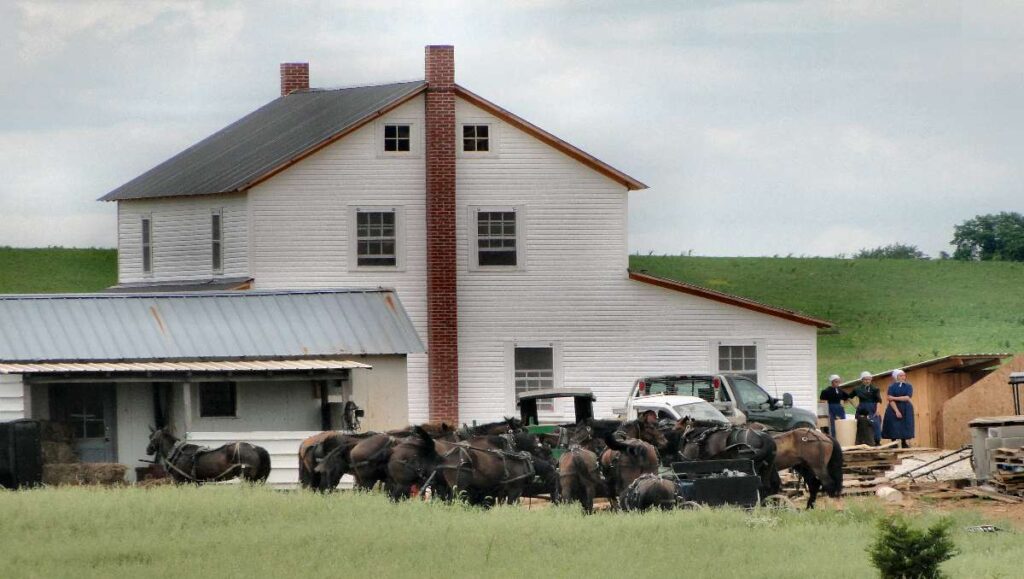
Amish homes reflect a lifestyle deeply rooted in simplicity and tradition. Stepping into one, you enter a world where every element is chosen with purpose and care, mirroring the values of the Amish community itself.
An Amish house is distinguished by its simplicity, absence of electrical fixtures, and the use of natural, locally sourced materials. These homes reflect Amish values of modesty, community, and a life unencumbered by modern technology, evident in their practical design and layout.
Discover the unique markers and values embedded in the architecture and environment of Amish homes, revealing how these structures symbolize a profound commitment to simplicity, community, and harmony with nature.
Key Characteristics of Amish Houses
Exploring these characteristics offers a window into the Amish philosophy of life and a deep connection with the natural world. The Amish demonstrate how simple living can be fulfilling and sustainable through their homes.
Here’s a tour of a traditional Amish home:
And an overview of the key characteristics of Amish houses:
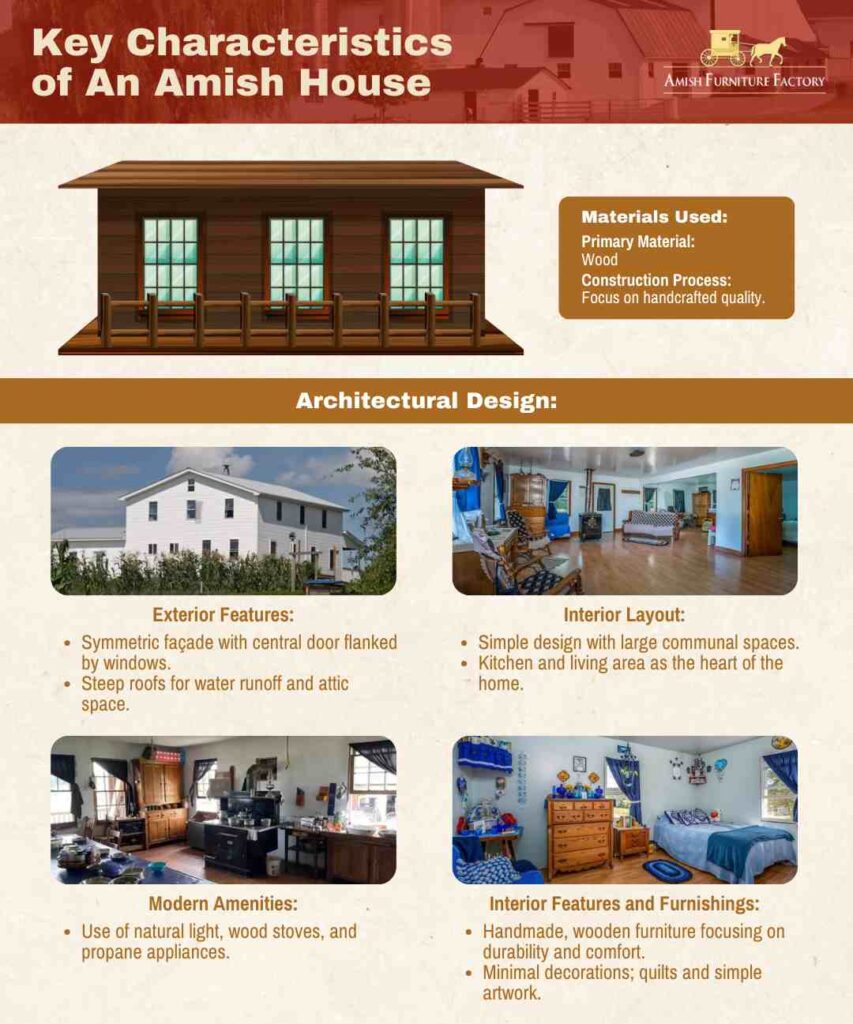
Materials and Construction of Amish Homes
Amish homes are built with a focus on durability and natural, locally sourced materials. Wood, sourced from the surrounding forests, is the primary material celebrated for its strength, versatility, and warmth it brings to the home.
Stone and brick also play a crucial role, especially in foundations and chimneys, providing stability and resilience against the elements. The construction process, emphasizing handcrafted quality and community effort, ensures that each home is not just a dwelling but a testament to the Amish way of life.
Architectural Design of an Amish House
Externally, these homes often feature a symmetric facade with a central door flanked by windows, which promotes balance and harmony. Roofs are typically steep, aiding in water runoff and providing ample attic space.
Internally, the layout is straightforward, with large communal spaces like the kitchen and living area serving as the heart of the home, facilitating family gatherings and communal activities.
Lack of Modern Amenities in Amish Homes
Amish homes forgo modern amenities that rely on electricity, such as conventional lighting, heating, and entertainment systems. Instead, natural light, wood stoves for heating, and propane-powered appliances are common.
This intentional omission is a cornerstone of Amish values, promoting a life focused on family and community rather than technology.
Amish Interior Features and Furnishings
Inside an Amish home, the furnishings and decor reflect the community’s ethos of simplicity and functionality. Amish furniture is handmade, often from wood, focusing on durability and comfort over style.
Decorations are minimal, with walls typically adorned with handmade quilts or simple artwork. The overall effect is warmth and welcome, with each item chosen for its usefulness and ability to foster a sense of togetherness.
The Role of Color and Decoration in Amish House
Amish homes reflect the community’s deep-rooted values through their careful selection of colors and minimalist approach to decoration. These choices create a distinctive aesthetic and serve as a daily reminder of the Amish way of life, emphasizing simplicity, purpose, and a close connection to the natural world.
Typical Color Schemes in Amish Architecture
The use of color reflects the Amish community’s values of simplicity and harmony with nature. These principles are manifested through their choice of colors:
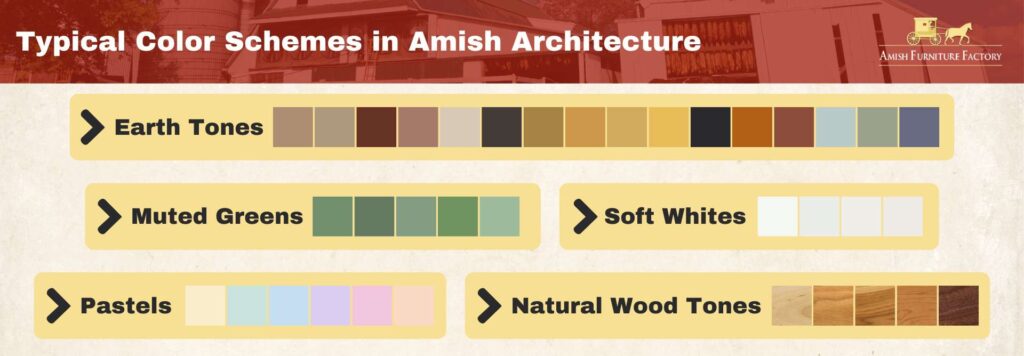
- Earth Tones: Shades like brown, beige, and terracotta are prevalent, drawing a direct connection to the soil and the land. These colors symbolize stability and the Amish’s agricultural roots.
- Muted Greens: Representing the foliage and grassy landscapes of their rural settings, muted greens embody the Amish’s close relationship with nature and farming.
- Soft Whites: Often used indoors for walls and ceilings, soft whites create a sense of openness and light, reflecting purity and simplicity.
- Pastels: Light blues, gentle pinks, and pale yellows might occasionally adorn interiors, offering a subtle nod to natural elements like the sky, flowers, and sunrise. These colors maintain the serene and modest aesthetic of Amish homes.
- Natural Wood Tones: Although not a ‘color’ in the traditional sense, the natural hues of wood used in furniture and structural elements is a hallmark of Amish design, celebrating the beauty of the material in its most unadulterated form.
The Minimalism in External and Internal Decorations
This restraint in over-decorating underscores the Amish belief that a home should be a place of tranquility and reflection, free from the distractions of excessive adornment. Here’s a closer look at how this minimalist approach to decoration is applied:
- Plain Exterior Walls: Amish homes typically feature unadorned exterior walls, often painted in a single, solid color or left in the natural hue of the building material, such as wood or stone. This lack of external decoration underscores the Amish emphasis on humility and simplicity.
- Simple Window Treatments: Windows may have simple, functional curtains or shutters, chosen more for privacy and controlling light than for ornamental purposes. The materials and colors are often subdued, blending with the home’s aesthetic.
- Handmade Quilts: While elaborate decorations are avoided, handmade quilts are a common sight, serving a practical purpose and adding a touch of warmth and color. Each quilt often passed down through generations, tells a story or symbolizes family heritage.
- Wood Furniture: The furniture is handcrafted from wood designed for durability and comfort without ornate details. The beauty of the furniture lies in its craftsmanship and the quality of the material rather than in decorative carvings or embellishments.
- Wall Hangings with Religious Texts: Decorations that do find a place in Amish homes often have religious or family significance, such as framed biblical verses or simple, homemade artworks that reflect their faith and values.
- Natural Floral Arrangements: In some cases, fresh flowers from the garden may be used to brighten a room, reflecting the Amish love for nature and the changing seasons. These are used sparingly and are typically not intended as permanent decorative elements.
Utility and Technology in Amish Homes
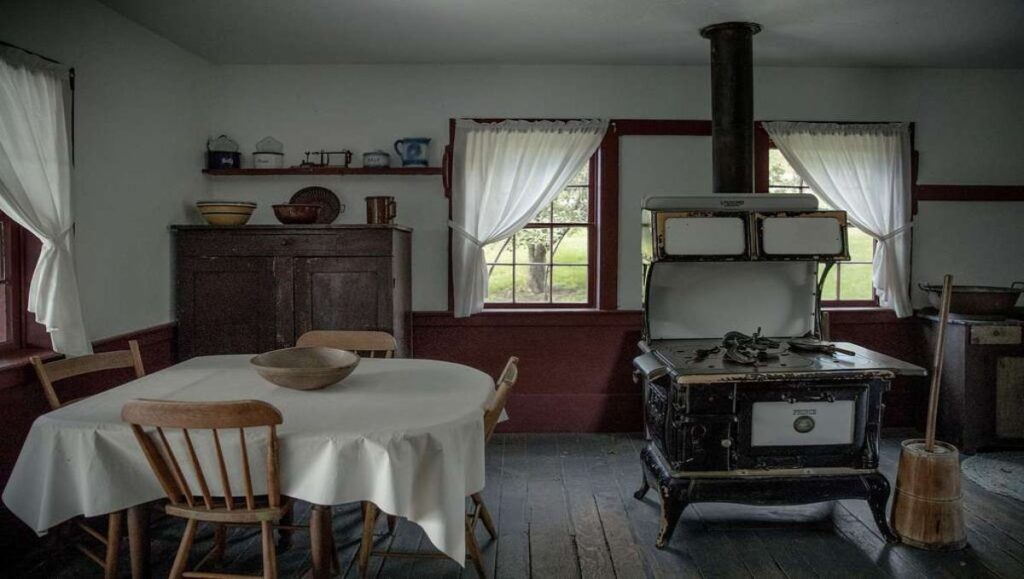
Contrary to popular belief, the Amish do not outright reject technology. Instead, as Professor Donald B. Kraybill, a leading authority on Amish culture, articulates:
“They don’t reject technology. They accept, reject or modify technology depending if it will help or harm their community. Lots of lessons for the rest of us in a hyper-tech world.”
This approach allows the Amish to thoughtfully incorporate technologies that align with their core values while rejecting those that could disrupt their way of life.
Lighting
Amish homes do not use conventional electric lighting. Instead, they opt for alternative sources such as propane or kerosene lamps. These practical lamps add a warm, inviting glow to the home.
In some communities, solar panels may charge batteries that power LED lights, reflecting a careful adoption of technology that does not directly connect to the public power grid.
Heating and Cooking
Wood stoves are a central feature in Amish homes, serving to heat the space and for cooking. The use of wood, a renewable resource, is consistent with Amish principles of stewardship of the earth.
In addition to wood stoves, many homes use propane heaters and cooking ranges, offering a degree of convenience while still avoiding reliance on electric utilities.
Refrigeration
Without electricity, traditional refrigeration is not an option in Amish kitchens. Instead, Amish families may use propane or gas-powered refrigerators, which are efficient and suitable for their needs.
Although less common now, iceboxes were traditionally used to keep food cool, utilizing ice harvested during the winter or purchased from non-Amish businesses.
Technology and Communication
While the Amish generally avoid using technology that connects to the broader society, such as television and the internet, they adopt certain technologies that support their work and community life.
For example, telephones might be shared within a community and in a central place, such as a phone booth, for emergencies or business purposes. Some communities also allow using battery-powered tools and equipment in workshops, acknowledging the need for efficiency in their livelihoods.
Landscape and Surrounding Environment
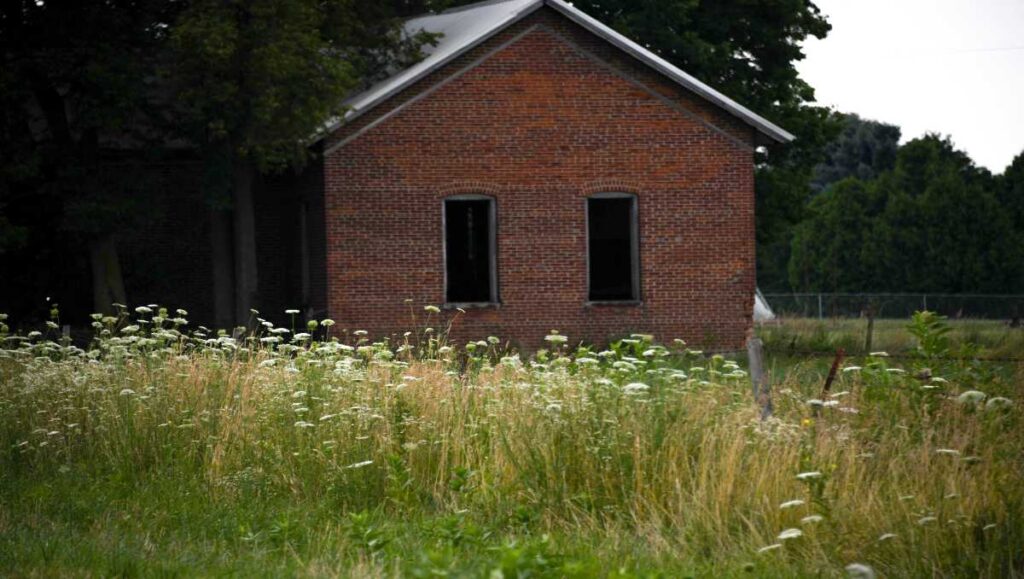
An Amish home’s landscape and surrounding environment are more than just a backdrop for daily life; they are expressions of deeply held values and a commitment to living in harmony with the world around them. Through their thoughtful stewardship of the land and intentional community design, the Amish offer sustainable, community-oriented living models.
Harmony with Nature
Amish homes are often set within landscapes with a deep connection with the natural world. Gardens, both vegetable and flower, are common, serving not only as sources of food and beauty but also as spaces for reflection and family work.
Large, well-maintained farms and fields extend around the homes, emphasizing the Amish commitment to agriculture and self-sufficiency. This integration with nature reflects the Amish belief in stewardship of the earth’s resources.
Sustainable Practices
Sustainability is not just a concept for the Amish; it’s a way of life evident in their land treatment. Crop rotation, organic farming practices, and the use of horse-drawn equipment to till the fields minimize environmental impact and promote soil health.
Rainwater collection systems and strategically planting trees and shrubs for wind protection and energy efficiency further showcase their sustainable approach to living.
Community Spaces
The layout of Amish communities is intentionally designed to foster a sense of belonging and cooperation. Homes are often built close to one another, facilitating easy access to communal activities and mutual aid.
Common areas, such as schoolhouses and meeting halls, are centrally located, serving as gathering points for worship, education, and socialization.
Integration with the Surrounding Environment
Amish homes and communities are designed to blend seamlessly into the surrounding environment. Buildings are often constructed with materials reflective of the local geography, such as wood from nearby forests or stone from local quarries.
This careful consideration ensures that Amish settlements enhance rather than detract from the landscape’s natural beauty, embodying their respect for God’s creation.
Comparing Amish Houses with Non-Amish Structures
The comparison between Amish and non-Amish houses reveals more than just architectural differences; it opens a window into contrasting ways of life, values, and interactions with the world.
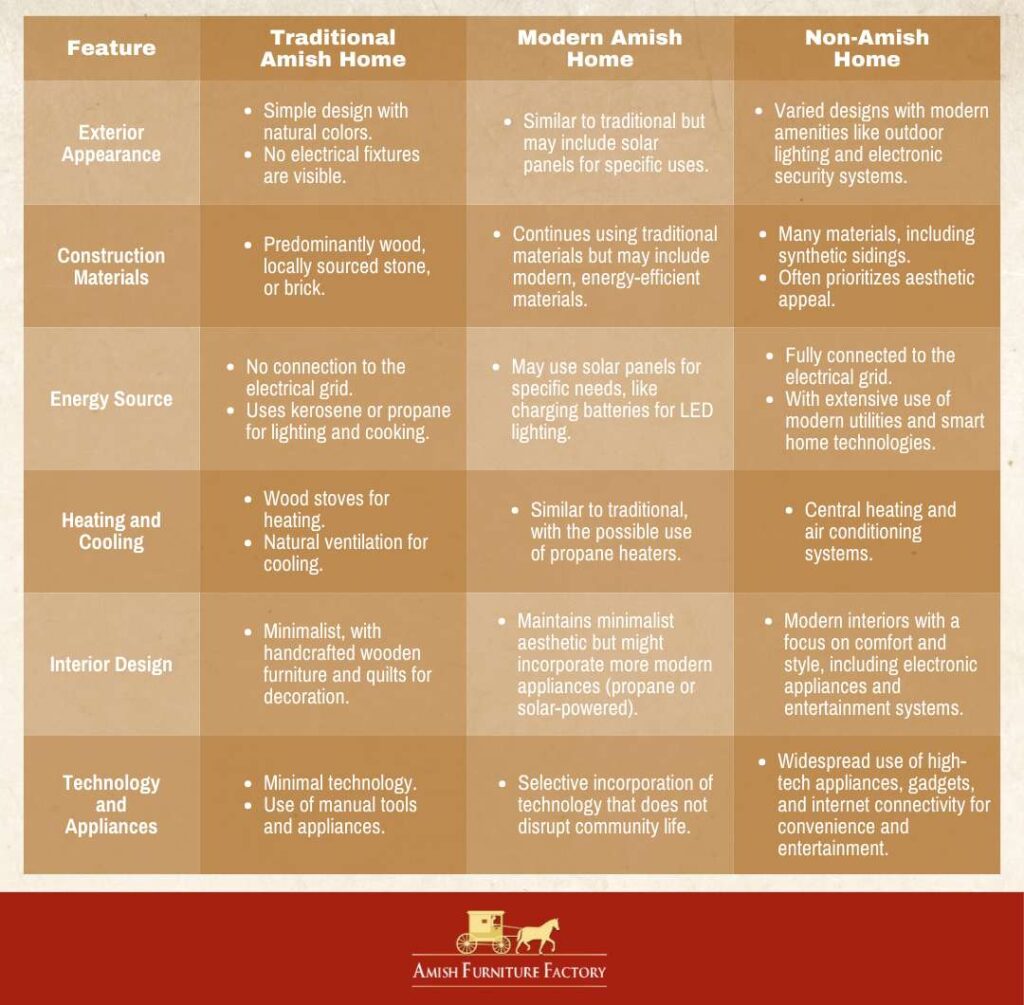
Design Philosophy
Amish houses are built with a focus on simplicity, functionality, and community living. The design eschews ornamentation for a clean, practical layout accommodating large families and communal gatherings.
In contrast, non-Amish structures often prioritize individual expression and architectural trends and may incorporate decorative elements that reflect personal taste or status.
Use of Technology
A fundamental difference lies in modern amenities and technology. Amish homes intentionally avoid electrical grid connections, relying on natural light during the day and propane or kerosene lamps at night.
Meanwhile, non-Amish homes are equipped with various modern conveniences powered by electricity, from HVAC systems to smart home technologies, reflecting a broader societal dependence on and integration with technology.
Environmental Impact
Amish building practices often emphasize sustainability and using natural, locally sourced materials. The environmental impact is crucial, with homes designed to blend into their surroundings and operate efficiently without modern utilities.
Non-Amish construction varies widely in this respect, with a growing trend towards green building practices and many homes that do not prioritize environmental sustainability to the same extent.
Community Integration
Amish homes are typically part of a closely-knit community structure, with homes often clustered together to facilitate mutual aid and social interaction.
Non-Amish residential design varies from urban to rural settings, with a wide range in the degree of community interaction and cohesion. Suburban and urban homes, in particular, may emphasize privacy and individual property, with community spaces more planned and less integral to daily life.
Understanding the Essence of Amish Homes
Identifying an Amish house goes beyond recognizing the absence of power lines or the simplicity of its design. It’s about understanding the profound values that shape every aspect of Amish life.
Every detail reflects a deliberate choice to live differently in the modern world, from the natural materials that blend homes seamlessly into their surroundings to the communal efforts that raise them.
As we observe these homes, we’re invited to see the architectural differences and appreciate the principles that guide a life of intentional simplicity and communal spirit.
